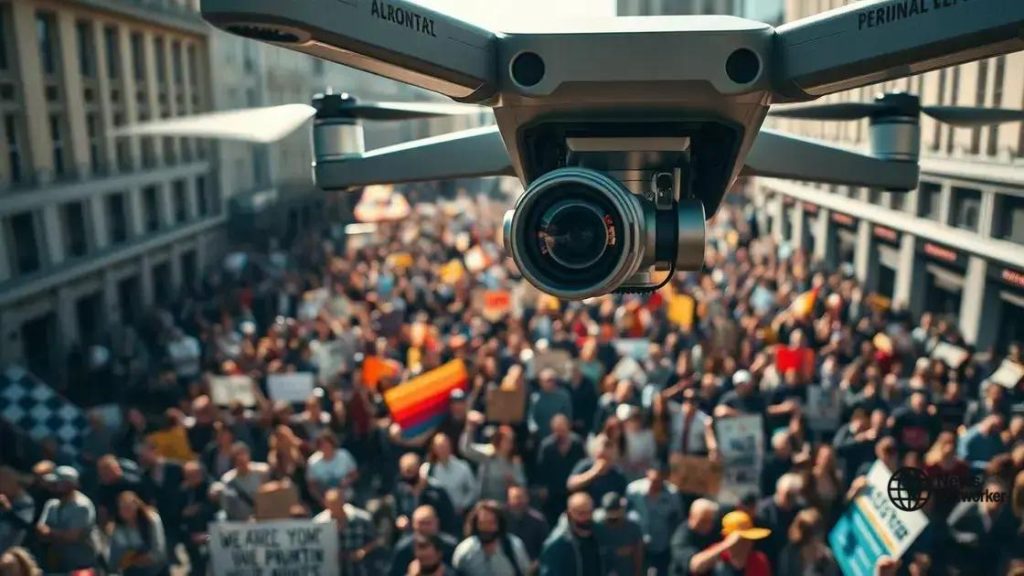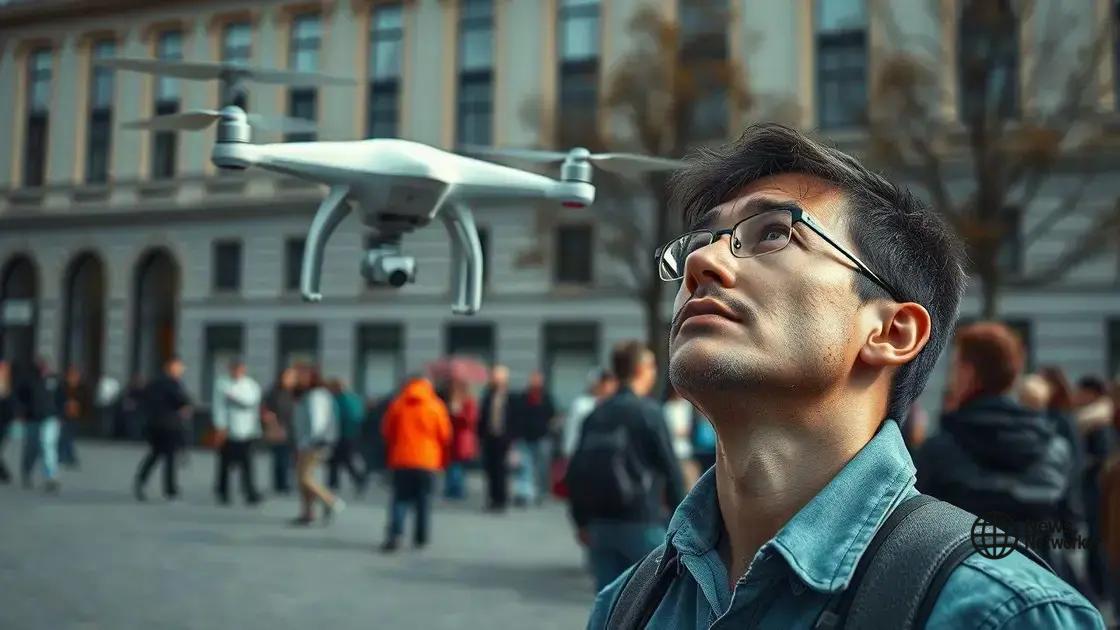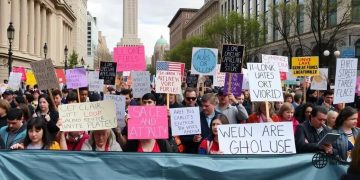Surveillance concerns over drone use in protests

In a drone-centric world, the future of protests poses challenges for privacy and civil liberties, prompting activists to adapt their strategies amid increasing surveillance.
Surveillance concerns over drone use in protests are becoming a pressing topic. As drones increasingly monitor demonstrations, what does this mean for privacy and civil liberties? Let’s delve into the ramifications together.
Understanding drone surveillance in protests
Understanding drone surveillance in protests is crucial in today’s rapidly evolving technological landscape. With the rise of advanced aerial technology, many are questioning the implications of using drones for monitoring public demonstrations.
Drones equipped with cameras can provide a bird’s-eye view of protests, which can be beneficial for law enforcement. However, this raises significant concerns about privacy and the potential for misuse of data. Various stakeholders, including activists and legal experts, are engaging in discussions about the ethical implications of this technology.
Benefits of Drone Surveillance
On one side, drone surveillance can enhance security during large gatherings. Drones can:
- Monitor crowd sizes and movements.
- Provide real-time information to law enforcement.
- Document events for safety and accountability.
Moreover, aerial views can assist in identifying potential threats and ensuring the safety of both protesters and bystanders. These capabilities can be instrumental in managing large crowds during demonstrations.
Concerns Raised by Drone Surveillance
Conversely, there are serious concerns about the implications of using drones during protests. The main issues include:
- The risk of mass surveillance and invasion of privacy.
- Potential for data misuse by authorities.
- The chilling effect on free speech and assembly.
The presence of drones may discourage individuals from participating in protests out of fear of being monitored. Activists argue that this could undermine the very essence of democratic expression. It’s essential for society to navigate these complex issues while considering the balance between security and individual rights.
As technology continues to advance, it’s vital to foster an open dialogue among citizens, lawmakers, and privacy advocates. The goal should be to establish clear guidelines for drone usage at protests to protect both public safety and civil liberties. By understanding the dual facets of drone surveillance, society can work towards a more balanced approach that respects individual rights while ensuring safety in public demonstrations.
Legal framework around drone usage
The legal framework around drone usage is complex and evolving. Laws governing drones vary greatly from one country to another, with different regulations addressing safety, privacy, and surveillance.
In many jurisdictions, drones are classified as aircraft, which means they must adhere to aviation regulations. However, these regulations often do not keep pace with technological advances. As drones become increasingly common, legal systems must adapt to address their unique challenges.
Key Regulations and Laws
Several key regulations affect drone operations:
- FAA Regulations (USA): The Federal Aviation Administration regulates drones for commercial and recreational use, requiring pilots to adhere to specific guidelines.
- Privacy Laws: In many regions, laws exist to protect individuals from being surveilled without consent. This is especially relevant when drones capture images or video during protests.
- Local Ordinances: Cities may implement their own rules that restrict drone flights over particular areas, especially during public demonstrations.
Understanding these laws can help both drone operators and protesters navigate the legal landscape effectively. It’s essential for drone users to remain informed about local regulations to avoid potential legal issues while using their devices.
Implications for Protests
The intersection of drone usage and protests raises significant legal questions. Events often attract public and media attention, leading to increased drone surveillance. This can result in:
- Enhanced monitoring by law enforcement.
- Concerns over the balance between public safety and individual rights.
- Potential legal actions against misuse of drone technology.
Public perception plays a vital role in shaping these regulations. As more people become aware of drone capabilities, there is a growing call for clearer laws and guidelines that protect both safety and privacy rights.
To foster informed discourse, stakeholders—including lawmakers, civil rights advocates, and the public—must engage in open discussions about the ethical use of drones in public spaces. Addressing these concerns is crucial for developing a legal framework that effectively regulates drone usage without stifling the right to protest.
Privacy implications of drone monitoring

The privacy implications of drone monitoring are critical to understand in our highly interconnected world. As drones increasingly watch over public spaces, concerns about individual privacy rights have intensified.
Many individuals feel uneasy knowing that their activities might be recorded without their consent. The feeling of being constantly surveilled can lead to a chilling effect, discouraging people from exercising their rights to protest and express their views.
Key Privacy Concerns
Several key privacy concerns arise with drone monitoring:
- Invasion of Privacy: Drones can capture images or videos of individuals in private moments or places, leading to significant privacy violations.
- Data Storage and Usage: There is often a lack of transparency about what data is collected and how long it is stored, raising questions about accountability.
- Potential Misuse of Data: Data collected via drones can be misused by authorities or even hacked, which could compromise personal security.
Understanding these issues is vital as they directly impact citizens’ freedoms. The ability to gather in public without being monitored is a fundamental aspect of democratic societies. When people fear they are being watched, they may hold back from participating in protests or community gatherings.
Legal Protections and Challenges
In some areas, existing laws do provide protections against unwarranted surveillance, but many laws do not adequately address the rapid growth of drone technology. New regulations must consider the balance between safety and privacy. As communities debate the role of drones in public life, the need for strong legal frameworks to protect individual privacy rights becomes increasingly clear.
Advocates argue for stricter regulations surrounding drone monitoring practices, emphasizing that individuals should have a right to know when and how they are being observed. Public discussions around these issues are crucial for developing standards that safeguard privacy while still allowing for legitimate uses of drone technology.
Public perception of drone surveillance
Public perception of drone surveillance varies significantly across different communities and regions. As drones become more prevalent in public spaces, how people view their usage is crucial for understanding the societal impact of this technology.
Many individuals express concern about privacy and the potential for abuse. Reports of drones surveilling crowds during protests can lead to a sense of unease among citizens. This discomfort can affect how people engage in public demonstrations, as the fear of being watched may discourage participation.
Factors Influencing Perception
Several factors influence public perception of drone surveillance:
- Media Coverage: Stories about drone misuse or privacy violations shape public opinion. Negative reports can increase fear and suspicion.
- Awareness and Education: Individuals who understand the benefits of drones, such as for search and rescue operations, may have a more positive view.
- Cultural Attitudes: In some cultures, there is a higher acceptance of surveillance technology, while others push back against it.
Understanding these factors helps in addressing public concerns. Transparency about how drones are used and the data they collect is vital for building trust.
Shifting Attitudes Over Time
Public attitudes towards drone surveillance can shift over time, especially in response to significant events. For example, during emergency situations, people may appreciate drone assistance for monitoring disasters or assisting first responders. However, as people become more aware of how these devices can track and surveil individuals, wariness may return.
In communities where drones are frequently used, such as urban areas, residents may become accustomed to their presence. This familiarity can sometimes lead to a more lenient view, leading to acceptance of the technology as a part of everyday life.
To foster a balanced view, it is essential for policymakers to engage with the community about drone surveillance. Providing education on the ethical use, legal frameworks, and potential benefits can help mitigate fears while encouraging productive discussions about privacy and surveillance.
Future of protests in a drone-centric world
The future of protests in a drone-centric world is becoming a subject of much debate. As drones become more common in monitoring public gatherings, their impact on the way people express dissent and advocate for change is significant.
Many activists worry that the increased presence of drones may deter participation in protests due to fears of constant surveillance. This concern brings into question what it means to protest in an age where technology can monitor and document every action.
Adapting Protest Strategies
Activists are likely to adapt their strategies to navigate a landscape where drones are prevalent. Key considerations include:
- Duration and Timing: Protests may become shorter and more spontaneous to avoid detection.
- Decentralized Movements: Groups may form decentralized networks to plan actions without centralized coordination, making them harder to surveil.
- Counter-Surveillance Techniques: Activists might employ counter-surveillance tools and tactics to protect their privacy.
These adaptations reflect an ongoing negotiation between technology and individual rights as communities find new ways to assert their voices in a surveillance-heavy environment.
Legal and Ethical Considerations
The legal landscape surrounding drone use during protests will also evolve. Advocates for civil liberties are likely to push for stronger regulations governing drone surveillance to protect the right to protest. This includes calls for:
- Clear Guidelines: Establishing policies that outline when and how drones can be used at public events.
- Rights to Privacy: Strengthening privacy protections to ensure individuals are not monitored without their consent.
- Accountability Mechanisms: Implementing systems that hold authorities accountable for drone misuse during protests.
Additionally, public discussion about ethical drone use is crucial. Engaging communities in conversations about the intersection of surveillance and activism can help shape a future where both rights and safety are respected.
Innovative technologies may also play a role in enhancing communication among protesters, making it easier to organize while minimizing risks. In conclusion, the future of protests in a drone-centric world presents both challenges and opportunities. The balance between surveillance and the freedom to protest will be pivotal in shaping social movements moving forward.
FAQ – Questions about Drone Surveillance and Protests
How do drones impact the nature of protests?
Drones can monitor crowds from above, affecting how protests are organized and perceived by both participants and authorities.
What are the main privacy concerns associated with drone surveillance?
Privacy concerns center around the potential for unwarranted monitoring, data collection without consent, and the chilling effect on free speech.
Are there any laws regulating the use of drones during protests?
Yes, many regions have laws that govern how and when drones can be used, but these regulations can vary significantly by location.
How might activists adapt their strategies to deal with drones at protests?
Activists may hold shorter, spontaneous protests or use decentralized organization methods to evade drone monitoring.





